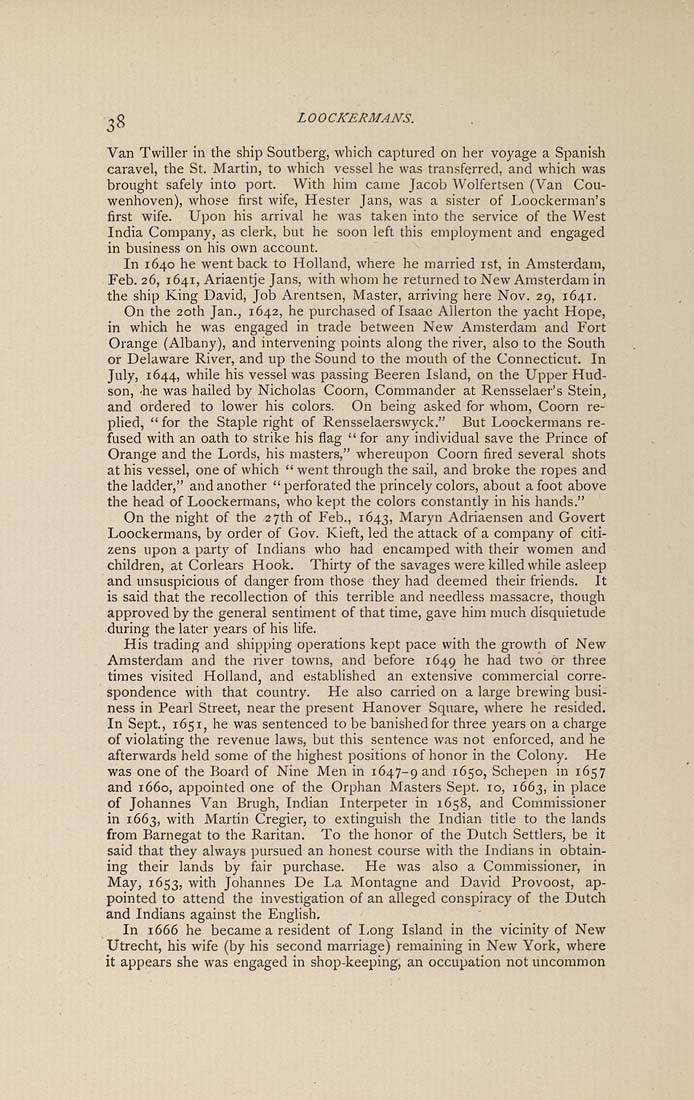, g LOO CKERMANS.
Van Twiller in the ship Soutberg, which captured on her voyage a Spanish
caravel, the St. Martin, to which vessel he was transferred, and which was
brought safely into port. With him came Jacob Wolfertsen (Van Cou¬
wenhoven), whose first wife, Hester Jans, was a sister of I^oockerman's
first wife. Upon his arrival he was taken into the service of the West
India Company, as clerk, but he soon left this employment and engaged
in business on his own account.
In 1640 he went back to Holland, where he married ist, in Amsterdam,
Feb. 26, 1641, Ariaentje Jans, with whom he returned to New Amsterdam in
the ship King David, Job Arentsen, Master, arriving here Nov. 29, 1641.
On the 20th Jan., 1642, he purchased of Isaac Allerton the yacht Hope,
in which he was engaged in trade between New Amsterdam and Fort
Orange (Albany), and intervening points along the river, also to the South
or Delaware River, and up the Sound to the mouth of the Connecticut. In
July, 1644, while his vessel was passing Beeren Island, on the Upper Hud¬
son, -he was hailed by Nicholas Coorn, Commander at Rensselaer's Stein,
and ordered to lower his colors. On being asked for whom, Coorn re¬
plied, "for the Staple right of Rensselaerswyck." But Loockermans re¬
fused with an oath to strike his flag " for any individual save the Prince of
Orange and the Lords, his masters," whereupon Coorn fired several shots
at his vessel, one of which " went through the sail, and broke the ropes and
the ladder," and another "perforated the princely colors, about afoot above
the head of Loockermans, who kept the colors constantly in his hands."
On the night of the 27th of Feb., 1643, Maryn Adriaensen and Govert
Loockermans, by order of Gov, Kieft, led the attack of a company of citi¬
zens upon a party of Indians who had encamped with their women and
children, at Corlears Hook. Thirty of the savages were killed while asleep
and unsuspicious of danger from those they had deemed their friends. It
is said that the recollection of this terrible and needless massacre, though
approved by the general sentiment of that time, gave him much disquietude
during the later years of his life.
His trading and shipping operations kept pace with the growth of New
Amsterdain and the river towns, and before 1649 he had two or three
times visited Holland, and established an extensive commercial corre¬
spondence with that country. He also carried on a large brewing busi¬
ness in Pearl Street, near the present Hanover Square, where he resided.
In Sept., 1651, he was sentenced to be banished for three years on acharge
of violating the revenue laws, but this sentence was not enforced, and he
afterwards held some of the highest positions of honor in the Colony. He
was one of the Board of Nine Men in 1647-9 and 1^5°) Schepen in 1657
and 1660, appointed one of the Orphan Masters Sept. 10, 1663, in place
of Johannes Van Brugh, Indian Interpeter in 1658, and Commissioner
in 1663, with Martin Cregier, to extinguish the Indian title to the lands
from Barnegat to the Raritan. To the honor of the Dutch Setders, be it
said that they always pursued an honest course with the Indians in obtain¬
ing their lands by fair purchase. He was also a Commissioner, in
May, 1653, with Johannes De La Montagne and David Provoost, ap¬
pointed to attend the investigation of an alleged conspiracy of the Dutch
and Indians against the English,
In 1666 he became a resident of Long Island in the vicinity of New
Utrecht, his wife (by his second marriage) remaining in New York, where
it appears she was engaged in shop-keeping, an occupation not uncommon
|








